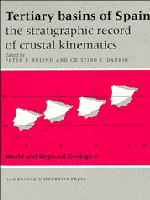Book contents
- Frontmatter
- Contents
- List of contributors
- Preface
- Dedication to Professor Oriol Riba IArderiu
- Memorial, Etienne Moissenet 1941–1994
- PART G GENERAL
- PART E EAST
- E1 Geological setting of the Tertiary basins of Northeast Spain
- E2 The lithosphere of the Valencia Trough: a brief review
- E3 Depositional sequences in the Gulf of Valencia Tertiary basin
- E4 Neogene basins in the Eastern Iberian Range
- E5 The Tertiary of the Iberian margin of the Ebro basin: sequence stratigraphy
- E6 The Tertiary of the Iberian margin of the Ebro basin: paleogeography and tectonic control
- E7 Stratigraphy of Paleogene deposits in the SE margin of the Catalan basin (St. Feliu de Codines – St. Llorenç del Munt sector, NE Ebro basin)
- E8 Onshore Neogene record in NE Spain: Vallès–Penedès and El Camp half-grabens (NW Mediterranean)
- E9 The Paleogene basin of the Eastern Pyrenees
- E10 The Neogene Cerdanya and Seu d'Urgell intramontane basins (Eastern Pyrenees)
- E11 Eocene-Oligocene thrusting and basin configuration in the eastern and central Pyrenees (Spain)
- E12 The Late Eocene–Early Oligocene deposits of the NE Ebro Basin, West of the Segre River
- E13 Chronology of Eocene foreland basin evolution along the western oblique margin of the South–Central Pyrenees
- E14 Evolution of the Jaca piggyback basin and emergence of the External Sierra, southern Pyrenees
- E15 Long-lived fluvial palaeovalleys sited on structural lineaments in the Tertiary of the Spanish Pyrenees
- E16 Evolution of the central part of the northern Ebro basin margin, as indicated by its Tertiary fluvial sedimentary infill
- E17 The Rioja Area (westernmost Ebro basin): a ramp valley with neighbouring piggybacks
- PART W WEST
- PART C CENTRE
- PART S SOUTH
- Index
E2 - The lithosphere of the Valencia Trough: a brief review
Published online by Cambridge University Press: 04 August 2010
- Frontmatter
- Contents
- List of contributors
- Preface
- Dedication to Professor Oriol Riba IArderiu
- Memorial, Etienne Moissenet 1941–1994
- PART G GENERAL
- PART E EAST
- E1 Geological setting of the Tertiary basins of Northeast Spain
- E2 The lithosphere of the Valencia Trough: a brief review
- E3 Depositional sequences in the Gulf of Valencia Tertiary basin
- E4 Neogene basins in the Eastern Iberian Range
- E5 The Tertiary of the Iberian margin of the Ebro basin: sequence stratigraphy
- E6 The Tertiary of the Iberian margin of the Ebro basin: paleogeography and tectonic control
- E7 Stratigraphy of Paleogene deposits in the SE margin of the Catalan basin (St. Feliu de Codines – St. Llorenç del Munt sector, NE Ebro basin)
- E8 Onshore Neogene record in NE Spain: Vallès–Penedès and El Camp half-grabens (NW Mediterranean)
- E9 The Paleogene basin of the Eastern Pyrenees
- E10 The Neogene Cerdanya and Seu d'Urgell intramontane basins (Eastern Pyrenees)
- E11 Eocene-Oligocene thrusting and basin configuration in the eastern and central Pyrenees (Spain)
- E12 The Late Eocene–Early Oligocene deposits of the NE Ebro Basin, West of the Segre River
- E13 Chronology of Eocene foreland basin evolution along the western oblique margin of the South–Central Pyrenees
- E14 Evolution of the Jaca piggyback basin and emergence of the External Sierra, southern Pyrenees
- E15 Long-lived fluvial palaeovalleys sited on structural lineaments in the Tertiary of the Spanish Pyrenees
- E16 Evolution of the central part of the northern Ebro basin margin, as indicated by its Tertiary fluvial sedimentary infill
- E17 The Rioja Area (westernmost Ebro basin): a ramp valley with neighbouring piggybacks
- PART W WEST
- PART C CENTRE
- PART S SOUTH
- Index
Summary
Abstract
Deep seismic profiling and gravity data show that the continental crust under the Valencia trough has been thinned by up to a factor of three in the centre, and that the uppermost mantle there has an unusually low density. Structural mapping in the borders of the Valencia trough shows important asymmetry, and there are asymmetrical features in the geophysical modelling. There are many aspects of the basin formation that are still to be worked out.
Introduction
The past decades have seen a rapid advance in our understanding of the deep structure of extended continental lithosphere. This advance has come primarily because of the integration of geological and geophysical data sets into self-consistent models of basin structure. The investigation of the Valencia Trough is an excellent example of the integrated use of geological and geophysical data to study the structure of a rift-type basin that developed in a region of convergence between the Eurasian and African plates (Fig. 1). The Trough is a small NE–SW-oriented basin in the Western Mediterranean located between the northeastern border of the Iberian Peninsula and the northeastern prolongation of the external zones of the Betic Chain (the Balearic Promontory) (Fig. 1). It is thought to be a basin that formed during a rifting event that began during Late Oligocene–Early Miocene.
- Type
- Chapter
- Information
- Tertiary Basins of SpainThe Stratigraphic Record of Crustal Kinematics, pp. 49 - 54Publisher: Cambridge University PressPrint publication year: 1996



